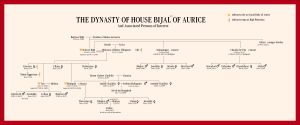Stalcast Bijäl
b 2538, Sakna Hurthin, Thrace; d 2590, Dawmoon, Asfengustrisa, Aurician Agogia. reigned 2574 to 2590, lifespan ~52. Son of Kalikán Buspa Bralcast Bijäl and Zandina of House Gattaniva, Stalcast Bijäl of House Bijäl of the Arveskupa Clan. The illustrious ruler of Aurice, Stalcast Bijäl exercised influence in the dismantling of the Thracian Empire and moderated the treatment of the royal family of Thrace, won prestige and power for Aurice with victory in the Fifth Geddamin War, oversaw the transition of Aurice into the modern age of Titancraft, and established the foundations of Aurician imperial power. Thracian-born, Stalcast was a capable warrior, participating in the Battle of Pytharnia on the Thracian side. He led the Grand Army of Aurice to victory against the Gorcorumbese in the Thyrian Peninsula. His legacy in modern Aurice remains strong despite the abolishing of the Grand Duchy. A small body of legends have arisen about the Grand Duke and his family, including the 'Curse of the House Bijäl.'
Bijäl established the Duchy of Aurice. When he later declared independence, he became Grand Duke. Bijäl helped the Thracians near the end of the Great Sky War, 2568 to 2575, and was entrusted to rule Aurice as a subject Viceroyal Duchy of the Thracian Empire. When the fortunes of the Thracian Empire and monarchy waned, he changed his allegiance, and established the Grand Duchy of Aurice. His betrayal was said to bring the Curse of the House of Bijäl and ensure their future overthrow. He began as duke of liberated Aurice and subsequently became Grand Duke, given the title by the Senate in acknowledgement of Aurice's sovereignty in 2576. Vice-royal Duke Stalcast Bijäl, subsequently Grand Duke Stalcast Bijäl, is regarded by most scholars as the greatest ducal ruler of Aurice. He was nicknamed the 'Red Griffin of Aurice.'

Early Life
Stalcast Bijäl was born 2538 in Sakna Hurthin, a large town in the foothills of the Jaggudorns, southwest of the Thracian capital, Dzan Kahisa.
Family Life
Bijäl married a Thracian aristocrat and had two legally recognized concubines as was not uncommon for high aristocrats during the late Thracian Empire. Children: by Mekarna of House Ullingama, Wife: [b 2559] Ersersa, daughter, [b 2561] Vast son, [b 2563] Ullana daughter, [b 2565] Rhungast son, [b 2567] Bethamena daughter, by Sulormingue 1st Concubine, [b 2580] Meglos son, [b 2581] Jemahlia daughter, [b 2583] Orsada daughter, [b 2584] Breckard son, by Chanda the Fair 2nd Concubine [b 2581] Stranclad son, [b 2583] Vallardun son, [b 2584] Chandallana daughter, [b 2585] Glafe son.
Office of Lukkha Sampushá of Aurice
King of Thrace, Ondaz Ädazund, wishing to find an obedient and competent governor to replace Kadvast Jafferund Agdaisak who had just perished in the Battle of Pytharnia, offered his father, Bralcast, the office of Lukkha Sampushá, (Vice-royal Duke), of Aurice. The king had considered the Bijäl family as they were low-ranking Thracian nobles who had proven their loyalty in the past and were thought free of the aspirations of high ranking nobles for independence and possibly treachery. Bralcast, already nearly aged sixty, privately petitioned for the office to be given to his eldest son. The king consented.
Cult of the Golden Phœnice
He introduced the worship of the Golden Phœnice from the high Jaggudorns as the state religion of Aurice. The priestess of the dwarven cult of the dragon-phœnix was brought from the Jaggudorns and ordained Mekarna, wife to Stalcast, in 2576 to be the first High Phœnissa of Aurice. She then organized the first priestesses of the same in 2576, choosing principally from her daughters and the daughters of Stalcast's two concubines. He accordingly changed the device of his House from the Red Griffin to the Golden Phœnix. He ordered the construction of the Temple of the Golden Phœnice (Aurice) in 2576. Cult observances were, consquently, held in the Temple of Aurice or in one of the other temples of Aurice in the mean time. The temple was not finished until 2638, requiring about sixty two years to construct.
Politics
He cunningly used threat of execution to persuade the Emperor of the Kalikán to cede Cisalpine Agogia to Aurice as part of the Treaty of Tauhad (2576). Stalcast did not actually threaten the emperor's life. However, the coalition who were occupying Thrace had privately considered the execution of the Emperor and Stalcast leaked this to the Emperor.
- 2576: Duke Stalcast Bijäl declares his independence and changes Duchy to Grand Duchy of Aurice. Later that year, he issues the Decree of Universal Emancipation throughout the Grand Duchy of Aurice (2576). For this reason and the subsequent Decree concerning Corundy, Stalcast Bijäl is called 'The Liberator.' After this, the Grand Duke used conscription to draft the newly emancipated subjects into the Aurician Grand Army to help him fight the Fourth and Fifth Geddamin Wars.
- 2576: Grand Duke sends agents to Skaligdæ to "secure the Thracian colony by whatever means expedient."
- 2578: founds Aurician Metropolitans Merchant College
The Shadevan War, 2589 to 2591, saw the Annexation of the Shadevan in 2589 AI. Stalcast died in Aurician Agogia before the conclusion of the war.
He commissioned Diomaive Triadeimot to design Palace Bijäl in 2581 which is today the Gubernatorial Palace, based upon traditional Hunting Lodge Architecture of Thrace.
- Bijäl orders Duke Midrethgourn Dio to lead colonization of southern Orrhymby by in 2582 AI.
He reorganized the ducal military of Aurice.
He was leader of Aurice during the Fifth Geddamin War (2582 to 2586) in which Aurice displayed marvelous military strategy and obtained secrets of Titancraft Vessel construction from the Gorcorumbese Geddamin who lost the war.
He established an academy for the study and development of titancraft for military purposes.
Stalcast's father, Bralcast died in Thrace in 2590 AI (aged 75 years). Grand Duke Stalcast returned to Thrace despite warnings of plots, to observe his father's funeral and to honor the holy shrine of the Golden Phœnice which stands in the high Jaggudorns. After the funeral and religious devotions, Stalcast died, aged 51, in a hunting accident in the Jaggudorns of Aurician Agogia. There is much conjecture about his death. His body was returned to Aurice and under magical preservation lied in state for nearly a year, until his wife asked the Noble Senate to have it interred in Aurice. His remains were subsequently removed to beneath the Palace of House Bijäl which is today the Gubernatorial Palace of Aurice.
Death
Stalcast Bijäl died from trauma to the head as a consequence of a fall during a hunting expedition. In In the month of Dawmoon, Bijäl returned to Thrace to observe the funeral of his father who had just died. Bralcast Bijäl. Subsequently, Bijäl, close friends, and retainers had flown by skycraft to the higher elevation of the northern Shadmaus, but still within the tree line and the weirs of the wyverns, for the purpose of hunting jadder. According to the official account, his hunting rifle mischarged, stunning and blinding him. A jadder pounced upon the Grand Duke and his fellows ran to deliver him. In the scuffle, the Grand Duke, blinded as he was, mis-stepped, fell down a short ravine and suffered a blow to his head. He was given first aid and then rushed to the skycraft to be taken to a mage healer. During the flight, he died. Much speculation has since arisen that his death was arranged by his political enemies in Thrace who saw him as a traitor to the monarchy.
Successor
Vast Bijäl was approved by the Noble Senate to ascend to the throne of the Grand Duchy of Aurice shortly after his father's death in 2590. He was robed and crowned amid much fanfare in Aurice with broad and ecstatic adulation of the public.
Legacy
The word 'bijälian' in Aurician History refers to the roughly fifty year period of the Rule of House Bijäl, 2574 to 2626. It can also mean triumphantly victorious. When used by Aurician Republicans, it can mean proud and machiavellian.
Chronology of Events in the Life of Stalcast Bijäl
- born 2538, Sakna Hurthin, Kingdom of Thrace, Son of Kalikán Buspa Bralcast Bijäl and Zandina of House Gattaniva, Stalcast Bijäl of House Bijäl of the Arveskupa Clan
- died 2590, Dawmoon, Asfengustrisa, Aurician Agogia in hunting accident
Sources
 Primary Sources
Primary Sources
- Collected Letters of Grand Duke Stalcast Bijäl, 2638
- Decree of Annexation of the Shadevan Provinces (2589), Grand Duke Stalcast Bijäl, 2589, Decree of Annexation of Shadevan Delta
- Decree of Grand Duke Stalcast Bijäl Concerning Corundy (2584), Grand Duke Stalcast Bijäl, 2584, Legal Decree that the mainland of Corundy is free from all Gorcorumbese Dominion
- Decree of Universal Emancipation throughout the Grand Duchy of Aurice (2576), Grand Duke Stalcast Bijäl, Legal Decree that all serfs are free and that lords may no longer claim their servitude.
- Grand Duke Bijäl's Address to the Grand Army before the Battle of Qusharya, 25??
 Secondary Sources
Secondary Sources
- The Battle of Pytharnia One Hundred Years Later, Ontairgain dalg Mehailgean, 2674, Pivotal Battle of Pytharnia in GSW, Pytharnian Language, translated into Medibgóëse Language and Asbardian Language shortly after first publication.
- Bijälian Imperial Strategy in the Shadevan, Jhatta ennekhá Danakh, 2682
- Bijälian Legacy, Fastorn Arvondunve, 2685
- Corundy and the Fifth Geddamin War, Rhionantis the Elder of Aurice, published 2611, Causes, Events, and interpretation of the Fifth Geddamin War, Throvian Language
- Curse of House Bijäl, Sorrega Tathaib, 2719; the work treats the last years of the life of Stalcast Bijäl, including his tragic death in a hunting accident, 3 Acts; libretto written in Tassan Language with some phrases in Thracian.
- Grand Duke Stalcast Bijäl: The Phœnix of Aurice, Vedaius Skain (2675 to 2746), 2713, comprehensive biography of Stalcast Bijäl from birth to death, Throvian Language
- Intrigues of the Late Bijälian Court, Perevath Chandomiddo, written 2700-2710, (covers 2574 to 2627, but focuses on 2590 to 2634, the reigns of Vast and Rhungast Bijäl and ending with the Battle of Kadraskan and the death of Rhoglos Bijäl)
- Origins of the Bijälian Dynasty, Pernora Ippekum, 2613
See Also
- Annexation of the Shadevan
- Aurice
- Aurician Empire
- Battle of Pytharnia, 2573
- Chronology of Aurice
- Chronology of the Aurician Empire
- Grand Duke Rhungast Bijäl
- Grand Duke Vast Bijäl
- House Bijäl
- Intrigues of the Late Bijälian Court
- List of the Rulers of Aurice
- Treaty of Tauhad (2576)
| This article is a stub. It requires further development by the creator. |

